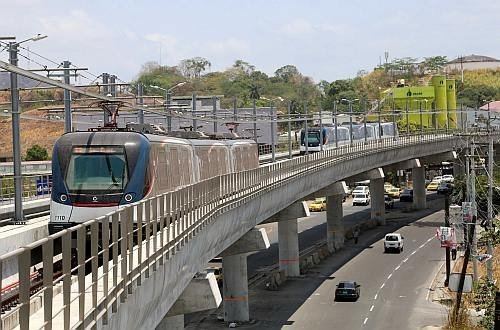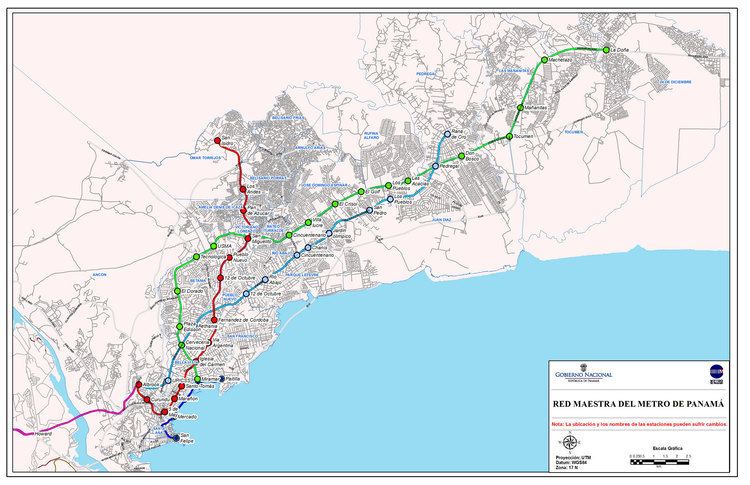Native name Metro de Panamá Daily ridership 180,000 (March 2015) Operator(s) El Metro de Panamá | Number of stations 141 more planned) Website El Metro de Panamá Began operation April 6, 2014 | |
 | ||
Character Partially underground, partially elevated Number of lines 1 (under construction, operational) | ||
The Panama Metro (Spanish: Metro de Panamá) is a metropolitan rapid transit system in Panama City, Panama, which currently links Los Andes County with the city center. It was inaugurated on April 5, 2014, and entered revenue service on April 6.
Contents
- Development
- Construction
- Cost
- Early operations
- Line 2 development
- Line 1
- Operating Hours
- Rolling stock
- Planned expansion
- References

It was built to relieve the traffic congestion between the city and San Miguelito District, and to offer commuters a viable alternative to road transport, as the Metrobus transport system is suffering multiple issues.

The Metro operates seven days a week and 365 days a year: Monday-Saturday 05:00-22:00 and on Sunday and holidays 07:00-22:00.

The Panama Metro is part of a major “National Master Plan” to improve transportation in Panama City and the west side of the country, which includes the construction of two more metro lines and a light rail line. It currently consists of one 15.8-kilometer (9.8 mi) line, serving fourteen stations, with a fifteenth station planned.

Development

The Government of Panama invited tenders for a contract to build the metro system. The governments of Brazil and Taiwan offered to invest on the project. After an exhaustive inspection of all proposals for the construction of the railway system, the Línea Uno consortium, which includes the Spanish Fomento de Construcciones y Contratas (FCC), won the contract.
In October 2009, the POYRY/Cal y Mayor y Asociados consortium won the contract for the counseling of the project development, and on January 2010, Systra was awarded a contract to create detailed infrastructure designs.
The first phase of the project consisted of planning, cost estimation, and technical feasibility, while the second phase consisted of several soil studies, topography, and demand refinings. Both phases were started and executed simultaneously at late 2009.
Construction
In December 2010, the government finally awarded the tender for the construction of the subway. The third and fourth phases of the project took place between 2011 and 2012, and consisted of the construction of all the viaducts and stations and relocation of the public utilities. The control center that supervises the whole metro operations and the Automatic Train Supervision were provided by Thales, along with the network infrastructure and communication and security solutions including CCTV, telephony, intercom, TETRA radio, visual and audio information to passengers, and fire detection.
By September 2013, construction of Line 1 was 92% complete, allowing a test run with some of the rolling stock.
Cost
The construction of Line 1 cost $1.452 billion. The Metro of Panama authority, in charge of the planning, construction, and execution of the project, has a budget of $200 million for the year 2012. In December 2011, the Secretaría del Metro de Panamá clarified that the updated cost of the project is US$1.880 billion, including public utilities relocations and engineering and project management costs.
Early operations
On April 5, 2014, the metro's Line 1 was inaugurated, and the first public passenger trips on the new system were carried out. The next day, April 6, it entered into active passenger revenue service. In its first year of operations the system carried 200,000 people per day on average, 25% more than had been expected.
The initial segment of Panama Metro's Line 1 ran over a mostly north-south route, from Los Andes to the Albrook bus station (where the system's maintenance shop is located), and extended over 13.7 kilometers (8.5 mi) of route, including 7.2 kilometers (4.5 mi) underground and 6.5 kilometers (4.0 mi) elevated. Initially, Line 1 had 11 passenger stations (with 3 more to be completed and opened after operations on Line 1 began): 5 elevated, 5 underground, and 1 at-grade. The twelfth station, Lotería, which was the sixth underground station, opened on August 27, 2014. The El Ingenio subway station, located between the underground Fernández de Córdoba station and the first elevated station, 12 de Octubre, was originally scheduled to open in August 2014, but opened on May 8, 2015.
The original northern terminus station of the metro was Los Andes. However, it was a temporary terminus station, since the government had approved an extension of Line 1 to a final elevated station in San Isidro. San Isidro was also originally scheduled to open in August 2014, but finally opened on August 15, 2015. The extension to San Isidro added 2.1 kilometers (1.3 mi) of route to the system, extending the metro's total route length to 15.8 kilometers (9.8 mi).
Line 2 development
On May 16, 2014, three different consortiums offered several proposals for planning, cost estimation and technical feasibility for the construction of a Line 2 of the Metro system. After making a detailed inquiry of all the proposals, the Metro de Panama secretary announced on July 12, 2014, that the PML2 consortium – which includes the Spanish "Ayesa Ingeniería y Arquitectura", "Barcelona Metro", and the "Louis Berger Group" company from the United States – had been awarded the contract. The Line 2 project will have a cost of $2.200 billion.
The construction contract was awarded to Linea 2 Consortium, formed by Odebretch from Brazil and FCC from Spain, the same consortium that built Line 1 of the Panama Metro. Construction officially started in September 2015. Originally, Line 2 had to be delivered in April 2019, but, since Panama City is hosting the Catholic World Youth Summit in January 2019, construction is being accelerated and the new delivery date is December 31, 2018 in order to serve the one million tourists expected to attend the summit.
Line 1
Panama Metro's Line 1 runs over a mostly north-south route, from San Isidro to the Albrook bus station (where the system's maintenance shop is located), and extends over 15.8 kilometers (9.8 mi) of route, including 7.2 kilometers (4.5 mi) underground. It has 14 passenger stations: 6 elevated, 7 underground, and 1 at-grade. The stations have a platform length of approximately 110 meters (360 ft).
A complete journey of Line 1 lasts about 25 minutes. It begins its current route at the elevated San Isidro station, north of the city, continuing on viaduct via the original terminus of Los Andes, Pan de Azucar station, San Miguelito station, Pueblo Nuevo (close to the Estrella Azul factory) to reach 12 de Octubre (the final elevated station), where it enters a trench, towards the underground section of Line 1. It continues its journey through the underground stations of El Ingenio, Fernandez de Cordoba, Vía Argentina, Iglesia del Carmen, Santo Tomás, Lotería, and 5 de Mayo. Finally it reaches the terminus station, Albrook, at Marcos A. Gelabert Airport (the secondary airport of Panama City), which is the system's only at-grade station.
There are also plans to develop an underground station in Curundú, between the underground 5 de Mayo station and the at-grade Albrook station, serving future city government facilities to be built at that location. It is expected to be constructed some time after the Metro has been opened.
Operating Hours
The Metro operates seven days a week and 365 days a year: Monday-Saturday 05:00-22:00 and on Sunday and holidays 07:00-22:00.
Rolling stock
Alstom has delivered 19 three-car Metropolis trainsets for the Panamá Metro. The trains were built at Alstom’s Santa Perpètua de Mogoda factory in Spain and underwent preliminary testing on the FGC network in Barcelona.
The first three trains were shipped from Spain and arrived May 25, 2013. The standard gauge units have air-conditioning, CCTV, and passenger information, and can accommodate 600 passengers per trainset. The trains initially consist of three-car sets, but all stations are being built to accommodate five-car trainsets in anticipation of expected future ridership demands.
Unlike many rapid transportation systems, the Panama Metro does not have a third rail. Instead, the trains collect their power from an overhead line system.
Planned expansion
The metro is eventually planned to extend to 8 lines, plus a branch line to the airport, by 2040. The first 5 lines will be metro lines, with the last 3 as tram lines.
Line 1 will extend by one station, running from Albrook to Villa Zaita.
Line 2 will run for 29 km from Parque Urraca, in the Punta Pacifica district to Felipillo and will be built in 3 phases. The first phase will run from San Miguelito to Nuevo Tocumen. It is expected that the first phase of construction will take up to four years. Construction on Line 2 broke ground on October 5, 2015, with construction expected to take 44 months.
The second phase will then extend this line from San Miguelito to Punta Pacifica located in the south part of Panama City. The final phase will extend the line by one station, from Nuevo Tocumen to Felipillo.
Line 3 is planned to have 14 stations and will run from Albrook station to Arraiján, Nuevo Chorrillo to the terminus in Ciudad del Futuro. The total length will be 26.7km. In April 2016, it was announced that Line 3 would be financed by a loan from the Japanese government, and use Japanese technology.
The final two metro lines, Line 4 and Line 5 will run from Pedregal - Via Israel and Costa Del Este to Obarrio, respectively.
The remaining lines will be tram lines. Line 6 will run from Albrook to Ciudad de la Salud. Line 7 through the Casco Antiguo district and line 8 from Don Bosco to Villa Zaita.
